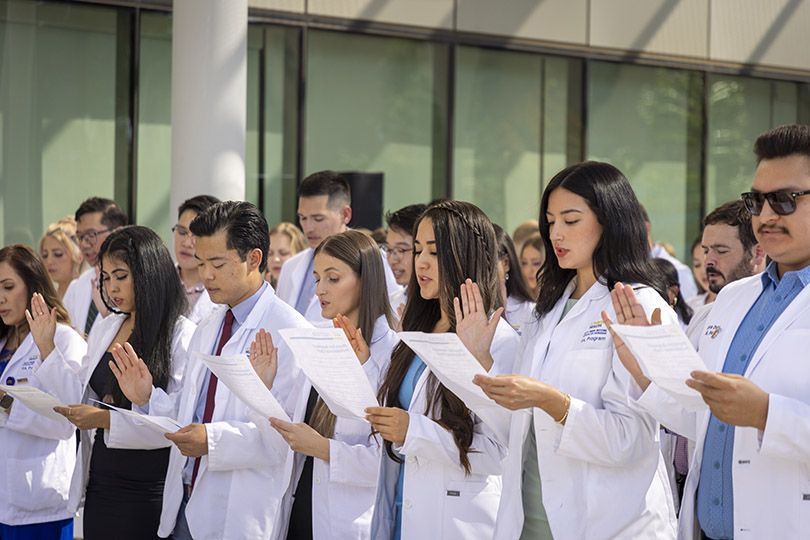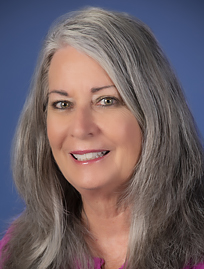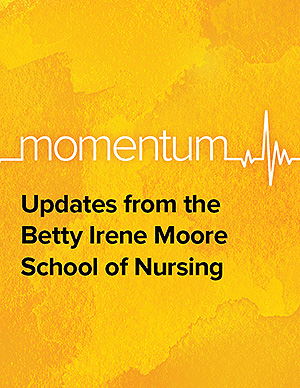Leadership message: Physician assistants go beyond
 PA students take the Physician Assistant Professional Oath during a ceremony at Betty Irene Moore Hall.
PA students take the Physician Assistant Professional Oath during a ceremony at Betty Irene Moore Hall.
 Teresa Thetford, director, PA Program
Teresa Thetford, director, PA Program
October 6-12 celebrates National Physician Assistant (PA) Week. During this week and throughout the month of October, we honor the history of the PA profession, reflect on its current status and discuss its future and growth.
A huge shoutout to the PAs at UC Davis, who play a crucial role in the health care system and make a positive impact on countless lives every day by providing high-quality, patient-centered care. I also want to thank those who teach future PAs who will make a difference in their patients’ lives and communities.
Thank you to the physicians who have, for years, supported PAs and nurse practitioners (NPs) and value the contribution of advanced practice providers to their practice and patients.
But if you still don’t know what a PA does, let’s start at the beginning.
What is a PA?
The official definition from the American Academy of PAs (AAPA) is that PAs (physician associates/physician assistants) are “licensed clinicians who practice medicine in every specialty and setting. Trusted, rigorously educated and trained health care professionals, PAs are dedicated to expanding access to care and transforming health and wellness through patient-centered, team-based medical practice.”
PAs play a vital role in the health care delivery team. There are currently 178,800 PA practitioners in the U.S., engaging in more than 500 million patient interactions each year (AAPA, 2024). The profession is also expanding internationally, with PA programs now in the UK and Ireland.
PAs practice in every specialty and work setting. The PA profession is regularly ranked among the top 5 health care, STEM and overall jobs in the U.S.
There are currently 308 accredited master’s degree PA programs in the U.S. PA programs take, on average, three academic years or 27 months to complete. Before starting PA school, applicants must complete between 1,000-2,000 hours of direct patient care. This is what “expedites” their progress in their medical education. PA students must also complete approximately 2,000 hours of clinical rotations during PA school in various areas and settings of medicine, including family medicine, internal medicine, pediatrics, women’s health, emergency medicine, mental health and surgery.
Graduates must pass a national certification exam and get licensed in the state in which they wish to work before they can work as a PA. To maintain certification, they must complete a minimum of 100 hours of continuing medical education (CME) every two years and take a national recertification exam every 10 years.
History of the PA profession
The PA profession was created to improve and expand access to health care in a team-based approach. In the mid-1960s, physicians and educators recognized a shortage of Primary Care physicians. To help remedy this, Eugene A. Stead Jr., M.D., of the Duke University Medical Center, put together the first class of PAs in 1965. He selected four Navy hospital corpsmen who had received considerable medical training during their military service. Stead based the PA program's curriculum on his knowledge of expediting the training of doctors during World War II. The first PA class graduated from the Duke University PA program on Oct. 6, 1967. You can watch a history of the PA profession on the AAPA website.
The PA concept was lauded early on and gained federal acceptance and backing as early as the 1970s as a creative solution to physician shortages. Physicians and the medical community helped support the new profession. It spurred accreditation standards, establishing a national certification process and standardized examination and developing continuing medical education requirements.
UC Davis saw this as an opportunity to improve access to primary care in the region, focusing on Northern California's medically underserved and rural areas. Thus, in 1974, UC Davis developed and opened the UC Davis PA Program housed in the School of Medicine. UC Davis was initially accredited as a certificate program from 1974 through 2014 and became a Master of Health Services—Physician Assistant degree in 2014. Along with the 2014 MHS-PAS transition, in 2013, the administrative home of the PA Program changed from the Department of Family and Community Medicine at the UC Davis School of Medicine to the new Betty Irene Moore School of Nursing at UC Davis.
For most of these years, the PA program and the UC Davis Family Nurse Practitioner (FNP) program were combined, with PA and FNP students taking the same courses and learning alongside each other from PA and NP faculty. In 2022, the FNP program transitioned to a Doctor of Nursing Practice (DNP) program.
In 2022, the AAPA approved the name change from physician assistant to physician associate. This name change is now being voted on state by state.
In 2023, US News & World Report ranked PA programs in the U.S. The UC Davis PA program was ranked #40 in the U.S. (out of then 310 programs).
Where the PA profession is now
The AAPA, our national organization, has a motto: “PAs Go Beyond”. But what does that mean?
The PA Profession has grown leaps and bounds over the past 57 years! PAs have become accepted members of the health care team. They have the medical education and skills to care for patients in various specialties, from primary care to surgery to emergency medicine and everything in between. They bring a unique perspective to patient care and treat patients holistically. PAs advocate for patients and improve health care for communities.
In January 2020, California State Bill 697, the PA Practice Act, was passed and implemented. This led to fewer restrictions for PAs providing care and decreased the administrative workload of physicians supervising and working with PAs. A few examples of changes with SB 697 include repealing the requirement that physicians must co-sign PAs' patient charts, no required formularies for PA prescribing and no state protocols determining supervision structure by the physician (instead, supervision is now determined by the physician with the PA).
In the 2023 Harris Poll, The Patient Experience: Perspectives on Today’s Healthcare, 90% of U.S. adults say the PAs are trusted health care providers.
Where the PA profession is headed
Although PAs have come a long way, there is still a long road ahead. Some health care providers still do not support PAs (or NPs) as providers, as evidenced in recent publications. There are concerns that PAs and NPs are taking jobs away from physicians. We, as advanced practice providers, need to work toward helping team members understand that PAs and NPs are here to augment the work of physicians and health care teams, improve access to health care, especially primary care access, and decrease gaps in health care. PAs recognize and value the importance of collaboration among all providers to achieve optimal patient care. This is an essential part of PA advocacy.
Thank you for this opportunity to talk about the PA profession! Please join us in celebrating National PA Week! Thank the PAs you work with and visit the Blaisdell Medical Library, where there will be activities and additional information this week. And please join us in spreading the word that “PAs Go Beyond.”
Yours in Health and Wellness,
Teresa Thetford, DHSc, MS, PA-C
Director, PA Program, Betty Irene Moore School of Nursing at UC Davis





